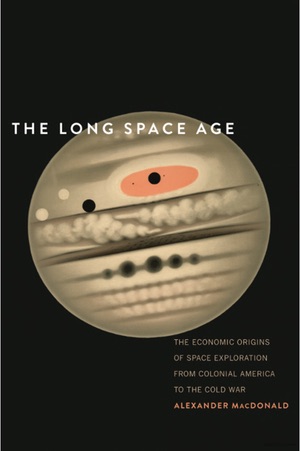Review: The Long Space Ageby Jeff Foust
|
| MacDonald concludes there are “well over a dozen astronomical observatories built in America in the nineteenth and early twentieth centuries that were of comparable relative economic significance to modern robotic spacecraft.” |
It is only novel, though, if one looks back just 60 years, to the canonical beginning of the Space Age with the launch of Sputnik. In his new book The Long Space Age, economist Alexander MacDonald takes the long view, arguing that space exploration, if not spaceflight itself, has roots that go back to the origins of the country. And that new reliance on private funding, he concludes, is hardly new at all.
Alexander’s assessment is based on looking at the long history of astronomical observatories in the United States. These were, he argues, instruments of space exploration, seeking to understand the universe. Americans sought to develop observatories in part for their prestige, demonstrating that the new country could be on the same footing as the old European powers. In his first message as president in 1825, John Quincy Adams lamented the lack of observatories in the country versus the more than 100 “light-houses of the skies” in Europe.
The observatories that were built in the decades to come in the US were privately funded. (Adams sought federal funding for a national observatory while president, but was rejected by Congress.) Many of the initial observatories were funded through subscriptions, with local citizens pitching in to pay for the observatory in exchange for membership to the local astronomical society, access to the telescope, or other benefits. By the late 19th century, funding shifted to a more philanthropic model, with wealthy businessmen covering the cost of observatories out of a personal interest, or perhaps to rehabilitate tarnished public reputations.
Those investments, MacDonald finds, were significant. When adjusted for “GDP ratio equivalent” dollars—the amount of money today that corresponds to the share of gross domestic product spent on the telescopes then—some observatories cost hundreds of millions of dollars. Lick Observatory, built in the 1870s and funded by the personal wealth of James Lick, costs $1.5 billion in present-day dollars using that GDP ratio equivalency calculation. MacDonald concludes there are “well over a dozen astronomical observatories built in America in the nineteenth and early twentieth centuries that were of comparable relative economic significance to modern robotic spacecraft.”
| At the end of the book, MacDonald describes a “sense of urgency in the efforts of modern space exploration advocates” fanned by fear of losing momentum from Apollo, one that he believes is misplaced. |
The book later explores the financing of Robert Goddard’s rocketry work. Goddard relied on modest funding from the Smithsonian, and during World War I sought military contracts for solid-fuel rockets he was working on. (That included, after the war, seeking contracts to develop rocket systems for the delivery of chemical weapons, “sobering evidence of the Faustian bargain that Goddard was willing to make in pursuit of his singular and obsessive dedication to spaceflight,” MacDonald writes.) That work didn’t really flourish until he received funding from the Guggenheim family, although Goddard returned to military work in his final years during World War II.
That history is overlooked by the influx of government funding during the Space Age, in particular the race to the Moon in the 1960s. However, both that effort and those earlier efforts shared in common the use of space exploration as “signaling” to demonstrate broader capabilities. Adams wanted a national observatory to put the US on the same footing as Europe; Kennedy wanted to land a man on the Moon to demonstrate technical superiority over the Soviet Union. Local observatories in American cities in the 19th century were also intended to demonstrate that their towns had come of age, to the point that building the observatory itself, and not funding the scientists who would use it, often became the priority.
In that sense, the new era of wealthy businesspeople putting hundreds of millions of dollars of their wealth—Bezos said earlier this month he sells $1 billion a year in his Amazon.com stock to pay for Blue Origin’s activities—is simply a return to that older model. MacDonald, who is an economist at NASA, is not advocating a return to solely private funding for space exploration, he notes in the conclusion. Instead, he argues that progress in spaceflight need not be measured only by what a government-funded agency does.
At the end of the book, he describes a “sense of urgency in the efforts of modern space exploration advocates” fanned by fear of losing momentum from Apollo, one that he believes is misplaced. “And yet, the long-run history of space exploration shows it to be an endeavor more robust in its support than often thought.”
